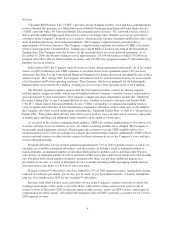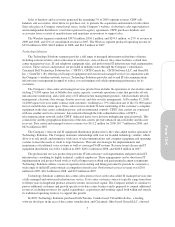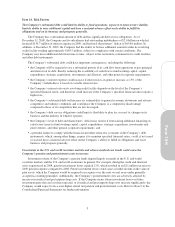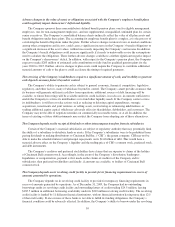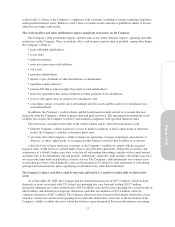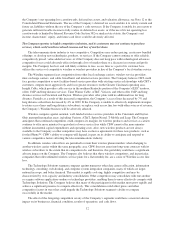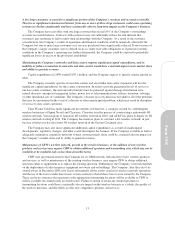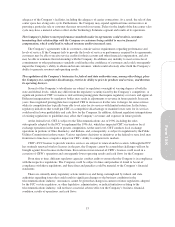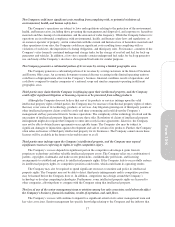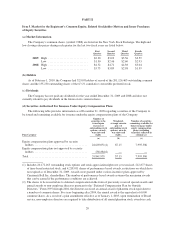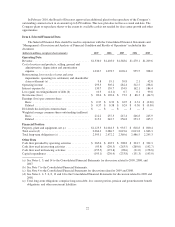Cincinnati Bell 2009 Annual Report Download - page 86
Download and view the complete annual report
Please find page 86 of the 2009 Cincinnati Bell annual report below. You can navigate through the pages in the report by either clicking on the pages listed below, or by using the keyword search tool below to find specific information within the annual report.Future declines in the fair value of the Company’s wireless licenses could result in future impairment
charges.
The market values of wireless licenses have varied dramatically over the last several years and may vary
significantly in the future. In 2009, the Company incurred a loss of $4.8 million on the sale of spectrum it was
not using in Indianapolis, Indiana. Further valuation swings could occur if:
•consolidation in the wireless industry allows or requires carriers to sell significant portions of their
wireless spectrum holdings;
•a sudden large sale of spectrum by one or more wireless providers occurs;
•market prices decline as a result of the sale prices in recent and upcoming FCC auctions; or
•significant technology changes occur.
In addition, the price of wireless licenses could decline as a result of the FCC’s pursuit of policies designed
to increase the number of wireless licenses available in each of the Company’s markets. For example, the FCC
auctioned an additional 90 MHz of spectrum in the 1700 MHz to 2100 MHz band in the Advanced Wireless
Services spectrum auction in 2006 and, in 2008, auctioned 62 MHz of 700 MHz wireless spectrum. If the market
value of wireless licenses were to decline significantly, the value of the Company’s wireless licenses could be
subject to non-cash impairment charges.
The Company reviews for potential impairments to indefinite-lived intangible assets, including wireless
licenses and trademarks, annually and when there is evidence that events or changes in circumstances indicate
that an impairment condition may exist. A significant impairment loss, most likely resulting from reduced cash
flow, could have a material adverse effect on the Company’s operating income and on the carrying value of the
wireless licenses on the balance sheet.
Failure to anticipate the need for and introduce new products and services or to compete with new
technologies may compromise the Company’s success in the telecommunications industry.
The Company’s success depends, in part, on being able to anticipate the needs of current and future
business, carrier, and consumer customers. The Company seeks to meet these needs through new product
introductions, service quality, and technological superiority. New products are not always available to the
Company, as other competitors may have exclusive agreements for those new products, such as the iPhone™.
New products and services are important to the Company’s success as its industry is technologically driven, such
that new technologies can offer alternatives to the Company’s existing services. The development of new
technologies and products could accelerate the Company’s loss of access lines and increase wireless customer
churn, which could have a material adverse effect on the Company’s revenue, results of operations, and cash
flows.
Terrorist attacks and other acts of violence or war may affect the financial markets and the Company’s
business, financial condition, results of operations, and cash flows.
Terrorist attacks may negatively affect the Company’s operations and financial condition. There can be no
assurance that there will not be further terrorist attacks against the U.S. and U.S. businesses, or armed conflict
involving the U.S. Further terrorist attacks or other acts of violence or war may directly impact the Company’s
physical facilities or those of its customers and vendors. These events could cause consumer confidence and
spending to decrease or result in increased volatility in the U.S. and world financial markets and economy. They
could result in an economic recession in the U.S. or abroad. Any of these occurrences could have a material
adverse impact on the Company’s business, financial condition, results of operations, and cash flows.
A health pandemic could severely affect the Company’s operations.
As a result of any health pandemic, such as the H1N1 influenza virus, the Company could potentially
experience a significant disruption in its operations due to staffing shortages as well as disruption of services and
products provided by third-party providers. Any significant disruption in its operations could have a material
adverse impact on the Company’s business, financial condition, results of operations, and cash flows.
16


